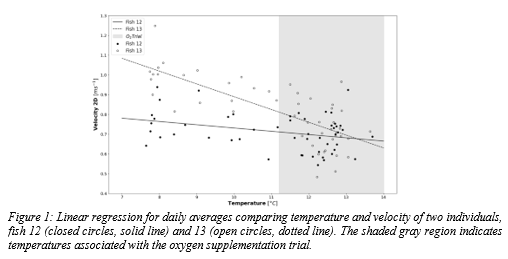THE EFFECTS OF OXYGEN SUPPLEMENTATION ON FARMED ATLANTIC SALMON Salmo salar BEHAVIOR USING ACOUSTIC TELEMETRY
Introduction
The solubility of oxygen in seawater is dependent on pressure, salinity, and temperature, where warmer waters decrease the solubility of oxygen. Temperature and dissolved oxygen (DO) togethe r play a crucial role in the growth and health of farmed fish (Elliott & Elliott, 2010). When DO falls below the optimal range (~6.0 mgL-1 at 15°C) fish stress and mortality levels increase. In the past few years, examples of mortality event have been documented worldwide, associated with hypoxic water events interacting with st ress from fac tors such as disease (Galea et al ., 2018; Evans, 2020). In order to counteract the negative effects of low DO on fish health , farms have initiated oxygen supplementation including pumping of oxygen nanobubbles via diffusers placed inside sea cages . The respons e of fish to changes in oxygen as well as the presence of bubblers was investigated on a commercial Atlantic salmon (Salmo salar ) farm using acoustic tags to monitor 3D fish position .
Materials and Methods
The farm study site is located in St. Margarets Bay, Nova Scotia, Canada with 6 net pens measuring 48m diameter with maximum depth of 11 m and arranged in one column running southwest to northeast. Fifteen adult salmon (60-72 cm and 4.5 kg) were surgically implanted with VEMCO acoustic tags (model V9P-180). An acoustic array was installed consisting of 8 HR2 receivers at 2 and 7m depth, used to triangulate horizontal position of each fish. Tags were programmed to transmit resulting data on 3D position every 3 seconds.
An oxygen supplementation trial was conducted in autumn 2019, during which compressed oxygen was continuously supplied to all cages on site. The study cage was supplied with 4 ring-shaped diffusers placed at 7m depth. No control cage was available due to the risk of fish mortality during low DO months. Temperature and DO data were collected using AquaMeasure wireless sensors in cage center at 2m and 7m depth.
Three fish variables were calculated using positioning data: velocity [ms-1 ], distance from cage center [m], and turning angle [°], and depth [m]. The study was split into two periods 1) during the oxygen trial (2 Oct 2019 – 7 Nov 2019) and 2) after the trial (8-25 Nov 2019).
Results
Temperature ran ged from ~8-14°C during the study , with similar values between 2 and 7m depths during the entire time series . There was a gradual temperature decrease through the autumn, then declining more steeply at the water column overturn in early November. Oxygen was always slightly higher at 2m than 7m, fluctuating over a range of 7-8.3 mg l-1 until the end of October when it rapidly declined to a low of 6.0 mg l-1. From that minimum, oxygen showed a continual increase throughout November to 9 mg l-1 during the fall overturn
Swimming velocity of the tagged population averaged 0.72 ± 0.39 ms-1 with higher velocities during the day than at night. Fish depth showed a daily cycle with deeper values during day than at night. The tagged population averaged 14.5 ± 5.1 m from cage center swimming in a counterclockwise direction with an average turning angle of 53.2 ± 44.1°.
During the oxygen trial, all tagged individuals displayed a slower swimming speed, negatively related to water temperature (Fig. 1), contrary to literature. Furthermore, 77% of tagged individuals showed a change towards cage edge during the trial compared to after, with 85% of tagged fish displaying straighter turning angles during the trial. During the trial, 85% of the tagged fish swam significantly shallower than after the trial.
Climate change is triggering increased sea surface temperatures and decreased dissolved oxygen, leading to more sites requiring supplemental oxygen. Our work suggests behavioural changes associated with oxygen supplementation . However the implications of these changes for feeding, growth, and fish health are not yet clarified . Continuously developing farm sensing technology associated with intervention such as oxygenation provides further scope for management options leading to improved fish welfare and more sustainable aquaculture.
References
Elliott, J. M., & Elliott, J. A. (2010). Temperature requirements of Atlantic salmon, brown trout and Arctic charr: predicting the impacts of climate change. Journal of Fish Biology.
Evans, O. (2020). Authorities investigating Mowi 20,000 salmon mortality . Retrieved from Salmon Business: https://salmonbusiness.com/authorties-investigating-mowi-20000-salmon-mortality/ . Accessed 21 March 2021.
Galea, S., Street, E., & Dunlevie , J. (29 May 2018). Macquarie Harbour salmon: 1.35 million fish deaths prompt call to ‘empty’ waterway of farms . Retreived from ABC News Australia: https://www.abc.net.au/news/2018-05-29/salmon-deaths-in-macquarie-harbour-top-one-million-epa-says/9810720 . Accessed on 1 April 2021.
